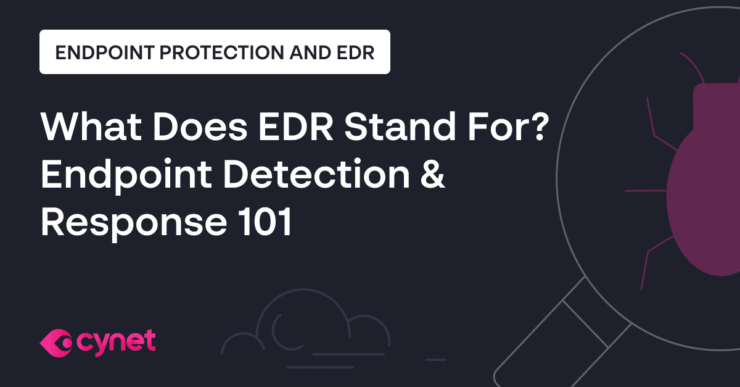EDR vs SIEM
To compare EDR and SIEM, let’s see some of the pros and cons of each type of solution.
Endpoint Detection and Response: Pros and Cons
Because EDR is primarily an endpoint security tool, it uses endpoint data as its primary telemetry source. There are some variants of the solution that also include some form of built-in network behavior analysis.
A strong advantage of EDR is that it can terminate advanced attacks at an early stage of the cyber kill chain. It does this by observing behavior patterns rather than examining logs.
Additionally, while SIEM can become quite expensive because its cost model is based on data consumption, EDR cost is based on a per-user flat rate, and is more controllable and predictable.
The downside of EDR is that it needs to be deployed across nearly all a network’s endpoints. This is complex to achieve in larger organizations. EDR—like any other solution—may trigger false positive alerts. Finally, an EDR solution can only be as effective as the security team employing it. Unfortunately, many organizations do not have the in-house expertise required to make use of EDR investments.
Learn more in our detailed guide to endpoint protection software.
Security Information and Event Management: Pros and Cons
SIEM is an excellent tool that can ingest a huge variety of data sources. Thanks to its log collection abilities, it is extremely useful for addressing compliance requirements. Its rich data analytics and multi-sourced data contextualization provide a powerful tool, indeed.
A main downside of SIEM is that it must be continuously fine-tuned. Its main constraint is the correlation rules that an organization needs to implement and continuously maintain as security needs and data sources change.
A SIEM requires specialized skills to operate effectively. Lastly, unlike EDR, it provides limited abilities to act on the data—once analysts discover a security incident, they must use other tools to contain and eradicate the threat.
A SIEM is an aggregator and analyzer. It aggregate logs from network infrastructure, but requires data from other security controls, like EDR. It cannot operate without underlying security controls that provide data and contain threats.
What is XDR?
Extended detection and response (XDR) is the next generation of traditional EDR. It can potentially detect attacks upon networks, endpoints, SaaS applications, cloud infrastructures, and any resource that is addressable within a network.
XDR can examine all network layers and application stacks, and provides advanced detection capabilities. Using automated correlation and machine learning, it can detect events that traditional SIEM solutions would miss, because they rely on static correlation rules.
XDR provides a proactive approach to detection and response by:
- Collecting pertinent data from operative security and information technology resources and transforming it using contextual information
- Using advanced behavior models based on machine learning, to help identify concealed threats
- Identifying and comparing threats that may exist throughout multiple layers of a network or the application stack
- Raising precise alerts together with the forensic data needed to investigate them, reducing workload and alert fatigue among security personnel
- Enabling security professionals to investigate indicators of a compromise quickly, identify responsive actions needed, and performing them through one interface
XDR vs. SIEM: A Focus on Response
One of the major differences between SIEM and XDR is the latter’s response capabilities. The SIEM response stage rests on human decisions. SIEM provides data and response paths, which a security analyst can quickly act on to mitigate a threat.
XDR provides automation and orchestration to make it easy to respond across all layers of the IT environment. Responses may include configuration changes, network segmentation, or other measures. XDR can integrate with firewalls, and IDS/IPS appliances, and network equipment to facilitate response.
Once properly configured, XDR can facilitate all three stages of the security cycle—initial analysis and triage; analysis by human security experts; recommending and orchestration response. This is why many industry experts agree in the long term XDR will not only replace EDR, but also traditional SIEM.
XDR with Cynet
Cynet’s XDR layer includes the following capabilities:
- Endpoint protection—multilayered protection against malware, ransomware, exploits and fileless attacks.
- Network protection—protecting against scanning attacks, MITM, lateral movement and data exfiltration.
- User protection—preset behavior rules coupled with dynamic behavior profiling to detect malicious anomalies.
- Deception—wide array of network, user, file decoys to lure advanced attackers into revealing their hidden presence.
Cynet 360 can be deployed across thousands of endpoints in less than two hours. It can be immediately used to uncover advanced threats and then perform automatic or manual remediation, disrupt malicious activity and minimize damage caused by attacks.Get a free trial of Cynet 360 and experience the world’s only integrated XDR, SOAR and MDR solution.


![Top 6 EDR Tools Compared [2025 Update] image](https://www.cynet.com/wp-content/uploads/fly-images/46568/ENDPOINT-PROTECTION-and-EDR_1200x6277-740x424.png)
